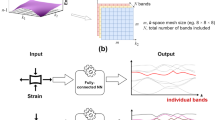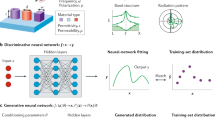Abstract
Many nanoscale devices require precise optimization to function. Tuning them to the desired operation regime becomes increasingly difficult and time-consuming when the number of terminals and couplings grows. Imperfections and device-to-device variations hinder optimization that uses physics-based models. Deep neural networks (DNNs) can model various complex physical phenomena but, so far, are mainly used as predictive tools. Here, we propose a generic deep-learning approach to efficiently optimize complex, multi-terminal nanoelectronic devices for desired functionality. We demonstrate our approach for realizing functionality in a disordered network of dopant atoms in silicon. We model the input–output characteristics of the device with a DNN, and subsequently optimize control parameters in the DNN model through gradient descent to realize various classification tasks. When the corresponding control settings are applied to the physical device, the resulting functionality is as predicted by the DNN model. We expect our approach to contribute to fast, in situ optimization of complex (quantum) nanoelectronic devices.
This is a preview of subscription content, access via your institution
Access options
Access Nature and 54 other Nature Portfolio journals
Get Nature+, our best-value online-access subscription
$29.99 / 30 days
cancel any time
Subscribe to this journal
Receive 12 print issues and online access
$259.00 per year
only $21.58 per issue
Buy this article
- Purchase on Springer Link
- Instant access to full article PDF
Prices may be subject to local taxes which are calculated during checkout






Similar content being viewed by others
Data availability
Data are available from the public repository https://data.4tu.nl at https://doi.org/10.4121/12884804.
Code availability
The custom computer code used here is available under the GNU General Public License v3.0 at https://github.com/BraiNEdarwin/SkyNEt.
References
Baart, T. A., Eendebak, P. T., Reichl, C., Wegscheider, W. & Vandersypen, L. M. K. Computer-automated tuning of semiconductor double quantum dots into the single-electron regime. Appl. Phys. Lett. 108, 213104 (2016).
Kalantre, S. S. et al. Machine learning techniques for state recognition and auto-tuning in quantum dots. Npj Quantum Inf. 5, 6 (2019).
Botzem, T. et al. Tuning methods for semiconductor spin qubits. Phys. Rev. Appl. 10, 054026 (2018).
van Diepen, C. J. et al. Automated tuning of inter-dot tunnel coupling in double quantum dots. Appl. Phys. Lett. 113, 033101 (2018).
Teske, J. D. et al. A machine learning approach for automated fine-tuning of semiconductor spin qubits. Appl. Phys. Lett. 114, 133102 (2019).
Chen, T. et al. Classification with a disordered dopant-atom network in silicon. Nature 577, 341–345 (2020).
Bose, S. K. et al. Evolution of a designless nanoparticle network into reconfigurable Boolean logic. Nat. Nanotechnol. 10, 1048–1052 (2015).
Lykkebø, O. R., Nichele, S. & Tufte, G. An investigation of square waves for evolution in carbon nanotubes material. In Proc. 13th European Conference on Artificial Life (ECAL) 503–510 (MIT Press, 2015).
Miller, J. F., Harding, S. L. & Tufte, G. Evolution-in-materio: evolving computation in materials. Evol. Intell. 7, 49–67 (2014).
Stepney, S. The neglected pillar of material computation. Physica D 237, 1157–1164 (2008).
Zwolak, J. P. et al. Autotuning of double-dot devices in situ with machine learning. Phys. Rev. Appl. 13, 034075 (2020).
Lennon, D. T. et al. Efficiently measuring a quantum device using machine learning. Npj Quantum Inf. 5, 79 (2019).
Durrer, R. et al. Automated tuning of double quantum dots into specific charge states using neural networks. Phys. Rev. Appl. 13, 054019 (2020).
Lapointe-Major, M. et al. Algorithm for automated tuning of a quantum dot into the single-electron regime. Phys. Rev. B 102, 085301 (2020).
Darulová, J. et al. Autonomous tuning and charge-state detection of gate-defined quantum dots. Phys. Rev. Appl. 13, 054005 (2020).
LeCun, Y., Bengio, Y. & Hinton, G. Deep learning. Nature 521, 436–444 (2015).
Hornik, K., Stinchcombe, M. & White, H. Multilayer feedforward networks are universal approximators. Neural Netw. 2, 359–366 (1989).
Werbos, P. Beyond Regression: New Tools for Prediction and Analysis in the Behavioral Sciences. PhD dissertation, Harvard Univ. (1974).
Rumelhart, D. E., Hinton, G. E. & Williams, R. J. Learning Internal Representations by Error Propagation Report 8506 (Institute for Cognitive Science, University of California, San Diego, 1985).
LeCun, Y., Bottou, L., Bengio, Y. & Haffner, P. Gradient-based learning applied to document recognition. Proc. IEEE 86, 2278–2324 (1998).
Ghiringhelli, L. M., Vybiral, J., Levchenko, S. V., Draxl, C. & Scheffler, M. Big data of materials science: critical role of the descriptor. Phys. Rev. Lett. 114, 105503 (2015).
Kalinin, S. V., Sumpter, B. G. & Archibald, R. K. Big–deep–smart data in imaging for guiding materials design. Nat. Mater. 14, 973–980 (2015).
Butler, K. T., Davies, D. W., Cartwright, H., Isayev, O. & Walsh, A. Machine learning for molecular and materials science. Nature 559, 547–555 (2018).
Carrasquilla, J. & Melko, R. G. Machine learning phases of matter. Nat. Phys. 13, 431–434 (2017).
Arsenault, L.-F., Lopez-Bezanilla, A., von Lilienfeld, O. A. & Millis, A. J. Machine learning for many-body physics: the case of the Anderson impurity model. Phys. Rev. B 90, 155136 (2014).
Cover, T. M. Geometrical and statistical properties of systems of linear inequalities with applications in pattern recognition. IEEE Trans. Electron. Comput. EC-14, 326–334 (1965).
Miller, J. F. & Downing, K. Evolution in materio: looking beyond the silicon box. In Proc. 2002 NASA/DoD Conference on Evolvable Hardware 167–176 (IEEE, 2002).
Rosenblatt, F. The perceptron: a probabilistic model for information storage and organization in the brain. Psychol. Rev. 65, 386–408 (1958).
Li, R. et al. A crossbar network for silicon quantum dot qubits. Sci. Adv. 4, eaar3960 (2018).
Hill, C. D. et al. A surface code quantum computer in silicon. Sci. Adv. 1, e1500707 (2015).
Veldhorst, M., Eenink, H. G. J., Yang, C. H. & Dzurak, A. S. Silicon CMOS architecture for a spin-based quantum computer. Nat. Commun. 8, 1766 (2017).
van Esbroeck, N. M. et al. Quantum device fine-tuning using unsupervised embedding learning. New J. Phys. https://doi.org/10.1088/1367-2630/abb64c (2020).
Moon, H. et al. Machine learning enables completely automatic tuning of a quantum device faster than human experts. Nat. Commun. 11, 4161 (2020).
Darulova, J., Troyer, M. & Cassidy, M. C. Evaluation of synthetic and experimental training data in supervised machine learning applied to charge state detection of quantum dots. Preprint at https://arxiv.org/abs/2005.08131 (2020).
Tsilipakos, O. et al. Toward intelligent metasurfaces: the progress from globally tunable metasurfaces to software-defined metasurfaces with an embedded network of controllers. Adv. Opt. Mater. 8, 2000783 (2020).
NI-DAQmx Python documentation (National Instruments Corp., 2017) https://nidaqmx-python.readthedocs.io/en/latest
SkyNEt library (Darwin team of the NanoElectronics group, Univ. of Twente, 2020) https://github.com/BraiNEdarwin/SkyNEt
Cheng, Y., Wang, D., Zhou, P. & Zhang, T. A survey of model compression and acceleration for deep neural networks. IEEE Signal Process. Mag. https://arxiv.org/abs/1710.09282 (2017).
Kingma, D. P. & Ba, J. L. Adam: a method for stochastic optimization. In Proc. 3rd International Conference for Learning Representations (ICLR). https://arxiv.org/abs/1412.6980 (2015).
Paszke, A. et al. PyTorch: an imperative style, high-performance deep learning library. In Proc. 33rd Conference on Neural Information Processing Systems (NeurIPS) 8024–8035 (2019).
Pedregosa, F. et al. Scikit-learn: machine learning in Python. J. Mach. Learn. Res. 12, 2825–2830 (2011).
Acknowledgements
We thank B. J. Geurts, U. Alegre Ibarra, B. de Wilde and L. J. Knoll for fruitful discussions. We are grateful to U. Alegre Ibarra for reading the manuscript carefully and providing useful input. We thank M. H. Siekman and J. G. M. Sanderink for technical support. We acknowledge financial support from the University of Twente, the Dutch Research Council (NWA Startimpuls grant no. 400-17-607) and the Natuurkunde Projectruimte (grant no. 680-91-114).
Author information
Authors and Affiliations
Contributions
H.-C.R.E., M.N.B. and J.T.W. performed the measurements and the DNN modelling. B.v.d.V. and T.C. fabricated the samples. H.-C.R.E., M.N.B., J.T.W., P.A.B. and W.G.v.d.W. wrote the manuscript and all of the authors contributed to revisions. W.G.v.d.W. and H.-C.R.E. conceived the project and designed the experiments with input from M.N.B. and J.T.W. W.G.v.d.W., P.A.B., H.B. and H.-C.R.E. supervised the project.
Corresponding author
Ethics declarations
Competing interests
The authors declare no competing interests.
Additional information
Peer review information Nature Nanotechnology thanks Matthew Dale, Gunnar Tufte and the other, anonymous, reviewer(s) for their contribution to the peer review of this work.
Publisher’s note Springer Nature remains neutral with regard to jurisdictional claims in published maps and institutional affiliations.
Supplementary information
Supplementary Information
Supplementary Figs. 1–6, Sections 1–4 and Tables 1–10.
Rights and permissions
About this article
Cite this article
Ruiz Euler, HC., Boon, M.N., Wildeboer, J.T. et al. A deep-learning approach to realizing functionality in nanoelectronic devices. Nat. Nanotechnol. 15, 992–998 (2020). https://doi.org/10.1038/s41565-020-00779-y
Received:
Accepted:
Published:
Issue Date:
DOI: https://doi.org/10.1038/s41565-020-00779-y
This article is cited by
-
Bioactive VS4-based sonosensitizer for robust chemodynamic, sonodynamic and osteogenic therapy of infected bone defects
Journal of Nanobiotechnology (2024)
-
Single-molecule chemistry with a smart robot
Nature Synthesis (2024)
-
Intelligent synthesis of magnetic nanographenes via chemist-intuited atomic robotic probe
Nature Synthesis (2024)
-
Toward a formal theory for computing machines made out of whatever physics offers
Nature Communications (2023)
-
Machine learning models for efficient characterization of Schottky barrier photodiode internal parameters
Scientific Reports (2023)



